Lax Rules Expose Kids To Lead-Tainted Water
Gaps in federal drinking standards leave schools and day care centers untested.

A selection of the nearly 400 day care centers and private schools in the Milwaukee area with lead service lines targeted for replacement. Clockwise from left: Open Hands Child Development Center, 1818 W. National Ave.; Young Achiever Learning Center, 1218 W. Walnut St.; Yeshiva Elementary, 5115 W. Keefe Ave.; and 3027 W. Greenfield Ave., which houses multiple day care and early learning programs. Photos by Pat A. Robinson of the Milwaukee Journal Sentinel courtesy of the Wisconsin Center for Investigative Journalism.
Almost two weeks into the school year, Melissa Corrigan got an email from the principal and superintendent of her daughters’ elementary school.Water from four West Middleton Elementary School faucets taken Sept. 1, the first day of school, had tested high for levels of lead or copper. As a safety precaution, the school would provide bottled water to students until the issue was resolved.
Corrigan — whose daughters Brooklyn and Carly are in first and fourth grades — thought little of the news, partly because the email told parents of the school west of Madison that it was “highly unlikely” that the water was unsafe to drink.
Any amount of lead can cause permanent brain damage, including reduced intelligence and behavioral problems, according to the U.S. Environmental Protection Agency. Infants and children are considered the most vulnerable to lead’s negative effects.
Fresh evidence of the risk of lead poisoning at school surfaced Friday when Milwaukee Public Schools revealed that testing found dangerous levels of lead in 183 drinking water fountains, including at locations hosting early childhood programs. The months-long testing program involved 3,000 water fountains at 191 school district buildings. The district said it had shut down and plans to replace the fountains that tested at or above the federal action level of 15 ppb, even though “federal and state regulations do not require schools to test drinking water.”
The district failed to respond to repeated questions since mid-November from the Wisconsin Center for Investigative Journalism about whether water at the schools was being tested for lead, and calls and an email to district spokespeople Friday were not immediately returned. The testing began in June.
Efforts to protect Wisconsin children in schools and day care centers from lead in their water have fallen short on several fronts, the Center has found. Among the problems uncovered by the Center in documents and interviews:
- There is a lack of testing for lead in drinking water consumed by children while away from home. Federal regulations enforced by the state of Wisconsin do not require most schools or day care centers to test at all. A 2016 USA Today investigation found that an estimated 90 percent of schools nationally are not required to test their water.
- There has been confusion over proper lead testing procedures at some schools, day care centers and public water systems in Wisconsin, as the Center has reported. This year, the state Department of Natural Resources waited nine months to send an official notice to public water system operators that the EPA had updated its testing recommendations in response to flaws uncovered by Flint, Michigan’s lead-in-water crisis.
- Lead service lines, a significant source of lead in drinking water, continue to provide water to hundreds of schools and day care centers around Wisconsin. In other communities, officials are not sure how many schools and day cares have lead pipes.
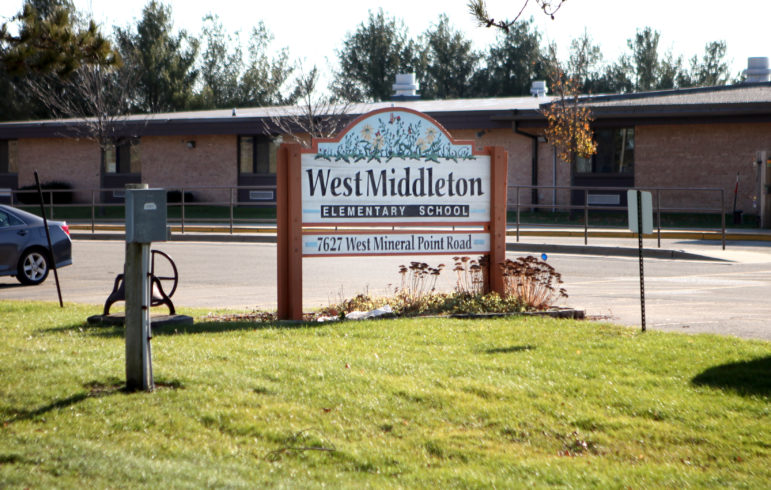
West Middleton Elementary School west of Madison found high levels of lead and copper in its water at the beginning of the school year. Later testing showed the levels were below federal action levels. The school replaced two of the four faucets and plans to replace the other two over winter break. Photo by Coburn Dukehart of the Wisconsin Center for Investigative Journalism.
Because of West Middleton’s rural Dane County location, the school has its own well and is among the minority of schools that must comply with some of the same testing requirements as municipal water systems.
Middleton-Cross Plains Area School District Superintendent George Mavroulis said after learning of the testing results, the school immediately shut off drinking water and consulted with a private testing company and a liaison from the DNR.
Two weeks after the initial test, the K-4 school with 400 students had the same faucets — and three water fountains — tested again. The levels of lead and copper returned to below the action level, and students and staff were again allowed to use the water.
“We tried to do everything in our power to make sure everyone was safe,” Mavroulis said.
The school has since replaced two faucets and plans to replace two more over winter break, he said. Perry Hibner, the district’s spokesman, said the school does not have lead pipes, but the building’s copper pipes may have lead solder.
Hibner believed two human errors caused the school’s initial water samples to be high in lead and copper: not flushing the system beforehand, as the DNR suggests after long periods of non-use like summer break, and removing the aerators from the faucets, which allowed a higher than normal water flow.
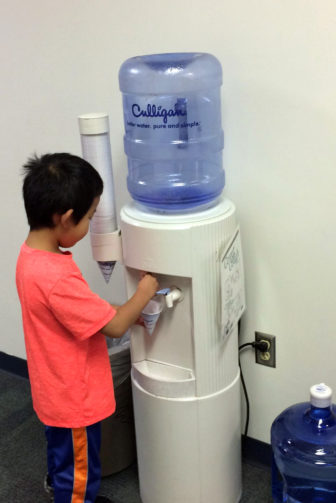
A child gets a drink from a water cooler at Riverside Elementary School east of Wausau on Dec. 7, 2016. More than 10 years ago, the school got rid of its drinking fountains and began providing water from coolers. The school also installed a filtration system after it discovered there were lead pipes in the building’s foundation. Photo courtesy of Riverside Elementary School.
Subsequent samples were taken after one hour of flushing and six hours of non-use.
The EPA issued new nationwide guidance in February clarifying that public water systems should not remove aerators or flush systems before sampling to avoid masking the level of lead in the water. DNR spokesman Jim Dick said West Middleton was in a “unique situation” because of its failure to previously flush the school’s system after the water had been stagnant for an extended period of time.
Going forward, however, the district will need to conduct two rounds of testing in the next year to assure the water is safe — and follow all of the appropriate sampling methods, he said.
After reviewing West Middleton’s test results, Yanna Lambrinidou, a Virginia Tech University researcher who helped train Flint researchers, said telling parents a health risk was highly unlikely was “a stunningly irresponsible statement, especially after Flint.”
Said Lambrinidou: “There is no safe level of lead in drinking water.”
There are also gaps when it comes to protecting children from lead in water at child care centers. All licensed day care centers in Wisconsin are required to identify and mitigate dangers from lead paint, but only centers that use private wells are required to eliminate lead hazards in drinking water, according to Joe Scialfa, spokesman for the state Department of Children and Families.
The USA Today investigation found that among schools and day care centers that are required to test, Wisconsin recorded the fourth-highest number of lead exceedances, with 24 between 2012 and 2015. Potential sources include lead pipes delivering water to and within the building, plumbing fixtures such as faucets and drinking water fountains, and solder used to join pipes.
Lead in small doses dangerous
Exposure to even small amounts of lead can cause permanent damage. A 2012 study of nearly 4,000 fourth-graders in Milwaukee showed that those with elevated levels of lead — even below what is considered dangerous — scored significantly lower on reading and math tests than those without elevated blood-lead levels. This negative effect was detected seven to eight years later, even after the study’s authors adjusted for social factors including family income and school attendance.
The Center reported in February that at least 176,000 homes and businesses in Wisconsin receive water from lead service lines, which account for 50 to 75 percent of lead contamination in public tap water, according to a 2008 study. Milwaukee — which required the use of lead pipes until 1948, when copper was also allowed — has at least 70,000 lead service lines.
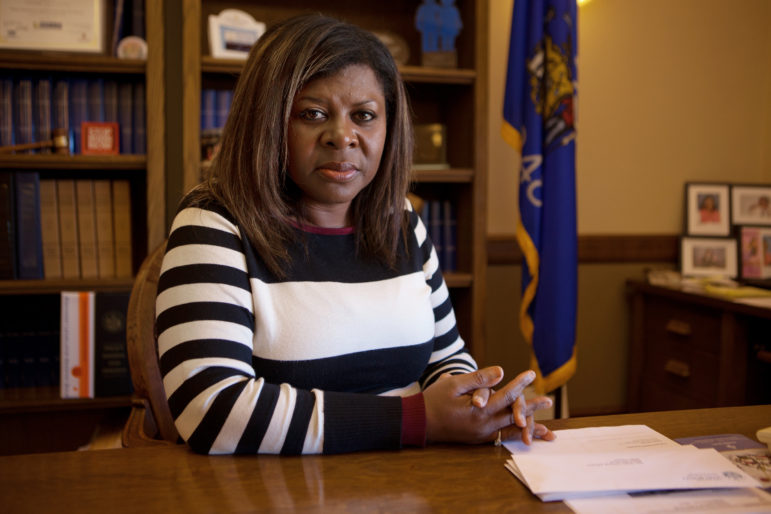
In February, State Rep. LaTonya Johnson, D-Milwaukee, introduced a bill that would require the state to conduct tap water testing when a child is lead-poisoned and would lower the level of lead in a child’s blood at which the state would be required to investigate its source. The bill was never brought up for a vote. Johnson, who used to run a day care center in her Milwaukee home, says she provided water from a cooler to the children in her care to avoid exposure to lead. Photo by Coburn Dukehart of the Wisconsin Center for Investigative Journalism.
Milwaukee says it has removed lead service lines leading to all of its public school buildings. Madison is thought to be the first city in the nation to remove all lead service lines from its water utility service area.
Milwaukee plans to focus $2.6 million from a new $14.5 million DNR program to begin replacing lead service lines leading to 384 licensed day care centers and 12 private schools in the city. In the meantime, the Milwaukee Health Department has advised those centers to test for lead, flush their taps if the water has been sitting in the pipes for several hours, consider using only filtered or bottled water for preparing formula, and cook with water from the cold water tap, which generally has less lead.
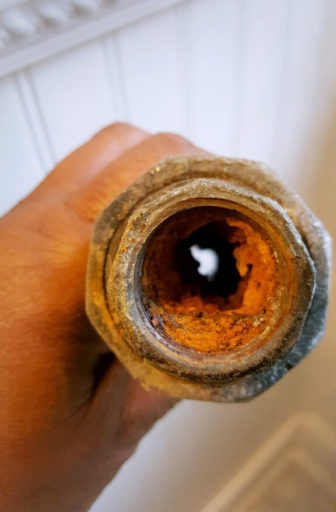
State Rep. LaTonya Johnson, D-Milwaukee, holds corroded galvanized plumbing that was removed from her Milwaukee house. Galvanized pipes, likely to be in older homes, can accumulate lead from service lines, such as the one supplying Johnson’s home. Johnson operated a home day care for several years before running for public office. Photo courtesy of LaTonya Johnson.
An additional 17 Wisconsin communities ranging from Antigo to Waterloo plan to use money from the program to replace lead service lines leading to their schools and day care centers.
School officials in Detroit, Chicago, Washington, D.C. and Massachusetts also have become increasingly concerned that lead is lurking in school water supplies. A testing program in Chicago identified more than 100 schools with lead-tainted water. A Massachusetts program launched in response to Flint found that more than half of the 300 public schools tested had unsafe levels of lead in the water.
Of particular concern: Day care centers where infants could be fed baby formula made with tap water, or toddlers could be eating food cooked in lead-laden water.
At a Sept. 7 water forum at Marquette University Law School, Milwaukee Mayor Tom Barrett said he has been assured by city health and public works officials that Milwaukee’s water is safe. But when he asked if the same is true for infants, the mayor said, their answer was “No.”
“So there, I think, is the issue,” Barrett said. “I would say for infants and children — that’s where you don’t want to have the lead exposure, and that’s where we continue to have some lead exposure in older homes.”
Rep. LaTonya Johnson, a Democrat from Milwaukee, operated a day care business out of her 90-year-old home for several years before running for public office. She said she used drinking water from a cooler until recently, when she spent more than $10,000 to replace corroded pipes throughout her northwest side house, which is served by lead service lines.
Johnson said many homeowners cannot afford projects like hers — and some day care providers might not know how to protect children from lead in drinking water.
“I’m sure people use sink water,” she said. “It’s right there.”
A ‘regulatory vacuum’
Residents and even officials often assume that drinking water is safe if it has been tested by a municipality. When a concerned parent called the Wausau School District last school year to ask if the district tested its water for lead, school officials referred the parent to the city of Wausau, which is responsible for testing municipal water.
But Wausau Water Operations Superintendent Scott Boers said the city only collects samples from residential buildings. Lead generally makes its way into water not at the water plant but as it travels through service lines and indoor plumbing, all of which could contain lead. Lead solder was used in structures built before 1984, and until 2014, plumbing components could still contain up to 8 percent lead.
Boers said none of the district’s buildings have lead service lines. The school district’s building and grounds director, Larry Cihlar, said testing is required only at the three facilities in the district which have private wells.
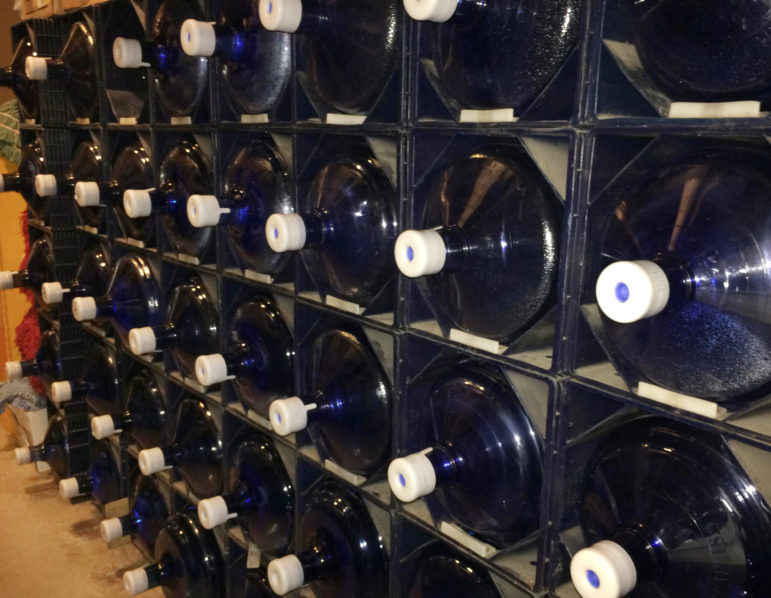
Riverside Elementary School east of Wausau spends an estimated $1,000 a month on bottled water for drinking to safeguard students from lead. After lead pipes were found buried in its foundation, school officials took out drinking fountains and installed a filtration system. Photo courtesy of Riverside Elementary School.
In the Lead Contamination Control Act, the EPA recommends that schools test water at each cold water tap — although no frequency is mentioned — share abnormal results with the public and take action to remediate any problems. Because these are recommendations, and not requirements, a school that tests its water and finds high levels of lead could choose not to share the findings with parents — and do nothing to fix the problem.
News investigations have shown that administrators in Newark, New Jersey, Portland, Oregon and Ithaca, New York knew about lead in water at schools for several months or years before the findings became public. Lambrinidou, the Virginia Tech researcher, and others decried the “regulatory vacuum” surrounding water testing in schools in a 2010 paper titled Failing Our Children.
“If you’re a parent, if the school is going to leave your child suboptimally protected, it’s better to know that they’re not doing much than to have false comfort that the schools are taking care of them,” Lambrinidou said.
The immediate solution for schools with elevated lead levels does not have to be costly, she said, noting that schools in Washington, D.C. and Baltimore are relying on filters and bottled water as they remove lead plumbing over time.
School leaders mixed on lead mandate
Clendon Gustafson, superintendent of the South Shore School District in Port Wing, said hearing of elevated lead levels in Milwaukee drinking water made him wonder about South Shore’s water.
“We’re preparing for the school year, and I thought halfway through August, ‘I don’t know if we’ve ever had our water tested for that.’ ” The district spent around $130 to test samples from five drinking fountains, which came back below the action level. Gustafson shared the results in the next school newsletter.
A Center survey of all 424 Wisconsin school district superintendents, including Gustafson, revealed a mixture of attitudes toward identifying and mitigating lead hazards. Most chose not to complete the survey at all.
The 47 respondents were split on whether there should be a statewide requirement that all public schools test their water for lead. While some do test — either voluntarily or because they have private wells — others said paying for testing is simply not an option.
“Yet another unfounded (sic) mandate????” one unnamed superintendent wrote. “Please no.”

Jon Bales, executive director of the Wisconsin Association of School District Administrators, says educational leaders do not oppose efforts to remove lead from schools’ drinking water but need additional funding to do it. Photo courtesy of Jon Bales.
A Fox 6 News investigation in May surveyed the 10 largest school districts in southeastern Wisconsin, asking if they had tested their schools for lead. Six answered; all said “No.”
Experts including Lambrinidou say even testing is not enough because lead levels in water fluctuate.
“You take 10 tests in a row — nine can show no lead at all,” she said. “And then the tenth can have parts in thousands of parts per billion because it’s a lead particle that just fell in the water.”Jon Bales
Jon Bales, executive director of the Wisconsin Association of School District Administrators, said most administrators support water testing. But if it identifies lead hazards that require costly remediation, he said, “We feel like there ought to be some federal support and state support to do that.”
His organization, as part of the national School Superintendents Association, has been pushing Congress to require municipalities to test school water quality during their required testing for compliance with the Lead and Copper Rule.
The group also is looking for “predictable funding” for school districts found to have a lead problem to pay for replacing lead service lines, lead fixtures and drinking fountains.
When officials at Riverside Elementary School east of Wausau discovered that lead from pipes in its foundation was leaching into the water, they opted to remove the school’s drinking fountains entirely. Assistant Superintendent Jack Stoskopf said the school relies on a filtration system for tap water and has spent about $1,000 a month over the past 10 years on bottled drinking water.
“That’s far less expensive than tearing up the foundation of the school and tearing up the pipes,” he said.
Crystal Wozniak, who lives in Green Bay with her 4-year-old son Casheous, said she considered the likelihood of lead being present in the water when deciding where Casheous would start a 3-K program in the fall. She chose a newly constructed school in the center of town over a building outside of town built several years earlier.
Casheous was lead poisoned when he was 9 months old, likely from chewing a windowsill covered in lead paint. Since then, Wozniak has educated others about eliminating possible sources of lead and advocated for required water testing, including in schools.
“The water at a school may be more harmful because they’re ingesting the water, and the food there is made with the water,” she said. “All the kids aren’t necessarily going around licking the walls, but they’re drinking the water.
The nonprofit Wisconsin Center for Investigative Journalism (www.WisconsinWatch.org) collaborates with Wisconsin Public Radio, Wisconsin Public Television, other news media and the UW-Madison School of Journalism and Mass Communication. All works created, published, posted or disseminated by the Center do not necessarily reflect the views or opinions of UW-Madison or any of its affiliates.
More about the Lead Crisis
- $43 Million Later, MPS Says Classrooms Are Safe From Lead Dust - Corrinne Hess - Dec 18th, 2025
- MPS Buildings Cleared of Lead-Paint Risks after 10-Plus Months of Work - Milwaukee Public Schools - Dec 17th, 2025
- Wisconsin Moves to Require Lead Service Lines Replaced By 2037 - Danielle Kaeding - Dec 11th, 2025
- Gov. Evers, DNR Announce More Than $159 Million to Ensure Clean, Safe Drinking Water for Wisconsinites in 29 Municipalities - Gov. Tony Evers - Dec 10th, 2025
- EPA Announces $3 Billion in New Funding for States to Reduce Lead in Drinking Water - U.S. Environmental Protection Agency - Nov 25th, 2025
- Wisconsin Communities Get $282 Million for Drinking Water Projects - Danielle Kaeding - Nov 19th, 2025
- MKE County: County Launches Lead Abatement Program - Graham Kilmer - Nov 9th, 2025
- Milwaukee County Launches Lead Remediation Program to Reduce Lead-Based Paint Hazards in Homes in Suburban Communities - David Crowley - Nov 5th, 2025
- Wisconsin Improves Child Lead Testing Rates, Urges Continued Testing and At-Home Prevention - Wisconsin Department of Health Services - Oct 21st, 2025
- City Hall: Milwaukee Must Replace 100 Lead Laterals Per Week To Meet 2025 Goal - Jeramey Jannene - Oct 1st, 2025
Read more about Lead Crisis here
Political Contributions Tracker
Displaying political contributions between people mentioned in this story. Learn more.
- March 29, 2016 - Tom Barrett received $100 from LaTonya Johnson
Tainted Water
-
Fecal Microbes In 60% of Sampled Wells
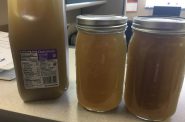 Jun 12th, 2017 by Coburn Dukehart
Jun 12th, 2017 by Coburn Dukehart
-
State’s Failures On Lead Pipes
 Jan 15th, 2017 by Cara Lombardo and Dee J. Hall
Jan 15th, 2017 by Cara Lombardo and Dee J. Hall
-
DNR Program Replaces Lead Laterals
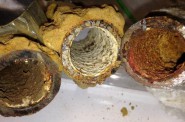 Dec 19th, 2016 by Cara Lombardo and Dee J. Hall
Dec 19th, 2016 by Cara Lombardo and Dee J. Hall


















There must be tons of lead in Milwaukee homes. I owned an old house that still had some lead pipes and I’m certain all the walls were covered in lead-based paint.
CORRECTION:
Actually, it is the PORTLAND WATER BUREAU that has not been optimally treating source water that would have minimized lead corrosion, for 20 years until today! Shamelessly, they maintain the building owners must take responsibility as well as the blame for lead-tainted water.
The Portland Water Utility (and Oregon DEQ regulating them) have violated the public trust, not to mention the Safe Drinking Water Act.